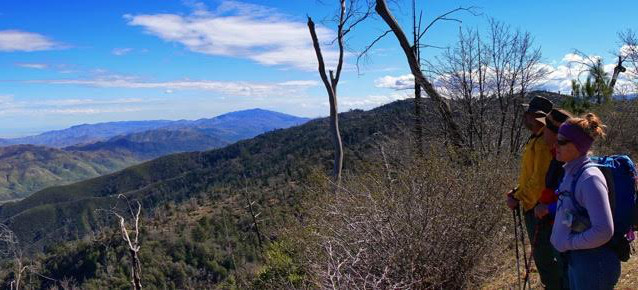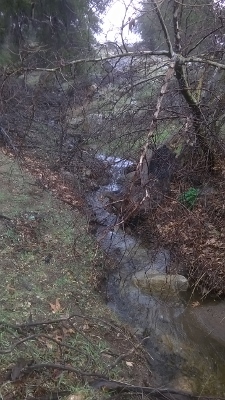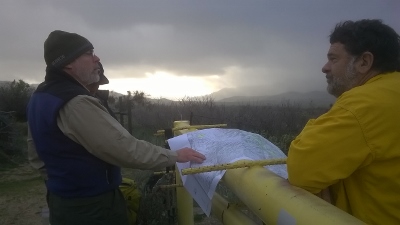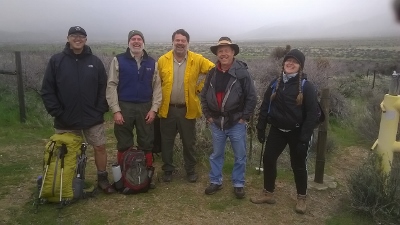
The Magic of Volcan Mountain: A Winter Transect Hike
By: Eric Jones, VMF Board Member
A recent two-day winter transect hike across the Volcan Mountain range with friends of the Volcan Mountain Foundation (VMF) has left me with a strong sense of the permanence, resilience and natural value of this rugged treasure. We have the sacred privilege to care about and care for this remote ecological gem just a short distance from millions of urban dwellers.
With permission from land owners and managers in hand, we five intrepid hikers set out in cloudy, blustery conditions from the San Felipe Valley near Banner Grade with the plan to summit Volcan's southern peak overlooking Julian, then head north along ranch and abandoned fire roads to near the high point of the range at Pechacho peak, finally to drop back down to S2 just north of Cerra de la Hechicera. Our overnight campsite was in the tall trees below the Sky Island Trail in the heart of the 400 acre VMF's Volcan Mountain Nature Center. It was a strenuous hike, covering nearly 16 miles and 6,000 feet of elevation gain.
Crossing the flats leading into Arkansas Canyon are ruins of the August Grand homestead giving testimony to 19th century European settlers carving out a living in a remote area, a multi-day journey from San Diego's commerce center. The steep overgrown wagon road to Simmons Flat is a marvel of man's determination and draft horse fortitude as it rises 2,500 feet from the valley. We ended our day hiking along the ridgeline trails that today's hikers, bikers and equestrians use to easily visit the meadows native people returned to for many hundreds of summers, and where early 20th century homesteaders struggled to endure the snowy winter storms.
Continuing north and favoring the eastern slope, we followed a small network of logging roads over the patchwork of land held in part in carefully stewarded preserves, and in part by families whose ownership reaches back for generations. These are sections of road rarely visited, and in many cases slowly returning to a natural state as the hills erode, saplings grow and the old trees fall.
Finally, we headed down. No longer on road or trail we crashed through nearly impenetrable chaparral, chest-high poison oak thickets (thankfully wintering and leafless!) and a deep ravine choked by storm-felled sycamore and canyon oak -- a two mile descent taking more than three and half hours.
I've spent some of the best days of my adult life traveling in nature and contemplating the value of places that are essentially wild and unchanged by human hands. The Volcan Mountains are deceptively close to civilization, yet seemingly a safe distance from its influence.
Over much of the earth, fields are easily tilled and subdivisions built -- on the plains of Kansas and the lowlands east of the Appalachian Mountains for instance, the land readily forms to the will of man. By contrast, some special land like Volcan has an essentially wild character that has earned the right to be unaltered by man.
People from the Kumeyaay, to the early European homesteaders, to today's proud ranching families have each left their light touches on the Volcan Mountains, but in the long run and aided in small ways by our continued vigilance, the range will ultimately retain its dominion.


